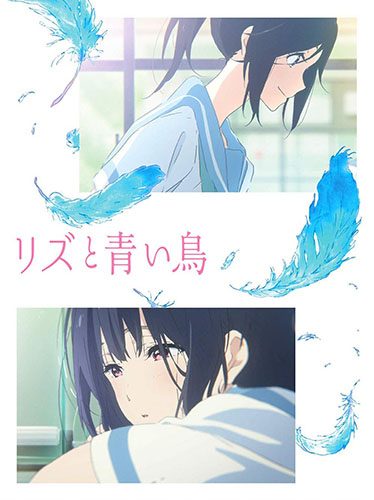
Wherever you go, there’s an endless sky.
- Episodes : 1
- Genre : Drama, Music, School
- Airing Date : April 12, 2018 USA: November 09, 2018
- Studios : Kyoto Animation
Contains Spoilers
Liz to Aoi Tori Introduction
Liz and the Blue Bird is a movie that reflects Naoko Yamada’s directing. For those unaware of her works (K-on!, Tamako Love Story, and A Silent Voice), Yamada is known as a youthful and talented director, famous for her ability to convey the unspoken word.
Naoko Yamada commands a mastery of body language, which she supplements further with floriography, the language of flowers. These elements are common in her work. Through them, she bonds the subtlety of one’s body with a spectrum of emotions.
Liz and the Blue Bird is a film that requires a careful touch. It borrows its setting from Sound! Euphonium, a series known for its impeccable music production and its emotional character-driven story. To not isolate new viewers, Liz and the Blue Bird focuses on a specific duo: Mizore and Nozomi.
Now that Mizore and Nozomi are seniors, this is the last year they can spend together. Their inevitable parting speaks through their new musical piece, “Liz and the Blue Bird.”

1. Purposeful and Considerate Directing
Nothing’s left to chance. Even simple shots will grow your understanding of the themes. What seems like coincidence, a few footsteps on beat to the music, the bread sticks that divides Liz and her customers (often happy families), the habitual tightening of red string for Mizore’s reed--all of this preps viewers to understand the film’s visual language.
The movie is gentle and considerate. People unattuned to Naoko’s directing have a point of reference, the actual folk tale: Liz and the Blue Bird. If viewers get lost on a scene’s meaning or are unfamiliar with either Euphonium or Naoko’s directing, a lot of the unsaid, internal drama of the film’s characters can be likened to the folk tale.
For such a simple story, the film has a lot of thought placed into it. Naoko’s style adapts Euphonium’s core ideas, revealing an aptitude with music that might surprise fans. Regardless of your film knowledge, Liz and the Blue Bird still strikes a melodious and beautiful chord.
2. Sincere and Natural Development

Liz and the Blue Bird carries itself confidently. Themes from the show flow into the movie, characters stay true to themselves, and music remains the driving force for the band. The film feels like a natural extension.
This natural feeling is important because the film, in some sense, feels like a sequel. However, it covers an issue that occurred before: the growing distance between Mizore and Nozomi. If the same problem occurs, then there’s a logical question, “Why does this occur again?”
Yamada makes the development feel sincere and realistic. Her skillful directing is an argument for the film’s necessity. Liz and the Blue Bird has the subtlety to convey the nuance of distance and parting.
3. Sounds Carried Visually
Sound! Euphonium, unsurprisingly, is aptly proficient when it comes to sound. The show’s technical mastery, however, might be lost on viewers inexperienced with band or music knowledge. Liz and the Blue Bird addresses this concern by playing music “visually” more often.
Short montages, notes played to the movement of a characters body, the subtle inflection of sound from an instrument while the camera is focused on a character’s face help with new viewers and listeners.
These decisions tie sound and visuals together, easing one’s understanding of music. The film develops its music alongside its characters, teaching viewers subtly, so at the end of the film, everyone can appreciate the film’s duet.
1. Unfamiliar Territory for New Viewers
The original show (Sound! Euphonium) had a visual theme for Mizore. Shots of her would be distant, indirect, and subdued--purposely pushing viewers away.
Understanding Mizore was implied: items she held in her hand, her body language she conveyed, and the feelings viewers shared as Mizore’s grew more distant. To state directly how she felt would be insincere. After all, even Mizore couldn’t say how she felt.
Fans of Euphonium are already familiar with this, but viewers might feel overwhelmed. Liz and the Blue Bird cannot state its meaning through words. It speaks just as the characters would.
Final Thoughts
Liz and the Blue Bird tells a simple story, but shows itself as much more. The emotional inflection of its characters initially sounds quiet, as if in another room. Its subtlety requires focus, its beauty coming through once you’ve pressed your ears to the door.
Naoko Yamada is masterful with unspoken dialogue, and this film stands as a testament for why Sound! Euphonium is so beloved. If you’ve never seen her directing or you’re curious why fans appreciate the series, Liz and the Blue Bird is the perfect piece to the puzzle.

